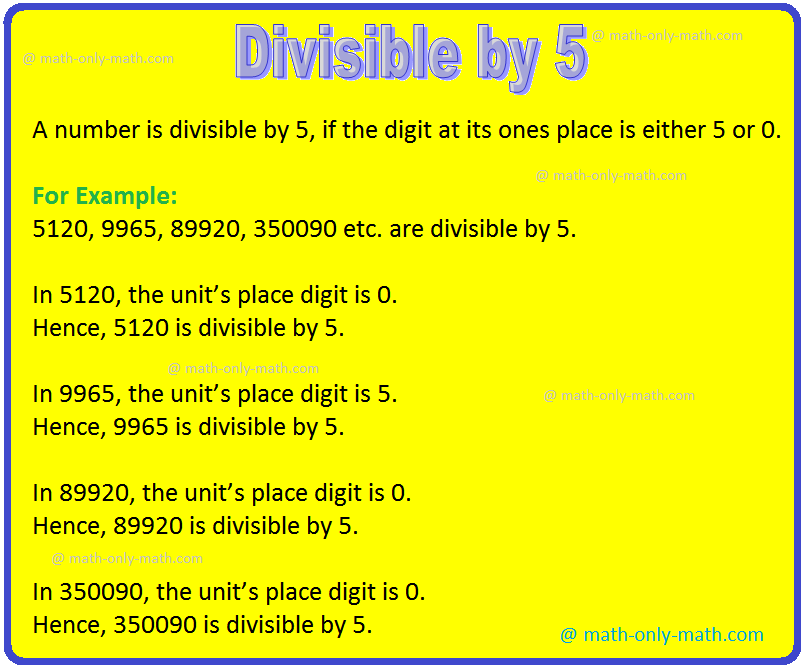Subscribe to our ▶️ YouTube channel 🔴 for the latest videos, updates, and tips.
Divisible by 5
Divisible by 5 is discussed below:
Consider the multiples of 5: 5, 10, 15, 20, 25, 30, 35, .........
All the multiples of 5 end with 0 or 5.
A number is divisible by 5 if its units place is 0 or 5.
1. Consider the following numbers which are divisible by 5, using the test of divisibility by 5: 50, 75, 90, 165, 120.
Solution:
(i) 50
In 50, the unit’s place digit is 0.
Hence, 50 is divisible by 5.
(ii) 75
In 75, the unit’s place digit is 0.
Hence, 75 is divisible by 5.
(iii) 90
In 90, the unit’s place digit is 0.
Hence, 90 is divisible by 5.
(iv) 165
In 165, the unit’s place digit is 5.
Hence, 165 is divisible by 5.
(v) 120
In 120, the unit’s place digit is 0.
Hence, 120 is divisible by 5.
Divisibility Rule for 5 Video
2. Consider the following numbers which are not divisible by 5, using the rules of divisibility by 5: 54, 77, 106, 127, 152.
Note: A number is divisible by 5 if the digit in the units place is 5 or 0.
Solution:
(i) 54
In 54, the unit’s place digit is 4.
Hence, 54 is not divisible by 5.
(ii) 77
In 77, the unit’s place digit is 7.
Hence, 77 is not divisible by 5.
(iii) 106
In 106, the unit’s place digit is 6.
Hence, 106 is not divisible by 5.
(iv) 127
In 127, the unit’s place digit is 7.
Hence, 127 is not divisible by 5.
(v) 152
In 152, the unit’s place digit is 2.
Hence, 152 is not divisible by 5.
Worksheet on Divisible by 5:
1. Which of the following numbers are divisible by 5?
(i) 815
(ii) 3464
(iii) 1900
(iv) 1238
(v) 460
(vi) 4945
(vii) 5555
(viii) 10000
Answer:
1. (i) 815
(iii) 1900
(v) 460
(vi) 4945
(vii) 5555
(viii) 10000
2. What is the smallest number that should be added to the following numbers to get a number divisible by 5?
(i) 174
(ii) 5008
(iii) 1836
(iv) 9912
(v) 251
Answer:
2. (i) 1
(ii) 2
(iii) 4
(iv) 3
(v) 4
Problems on Divisibility Rules
Worksheet on Divisibility Rules
From Divisible by 5 to HOME PAGE
Didn't find what you were looking for? Or want to know more information about Math Only Math. Use this Google Search to find what you need.



New! Comments
Have your say about what you just read! Leave me a comment in the box below. Ask a Question or Answer a Question.